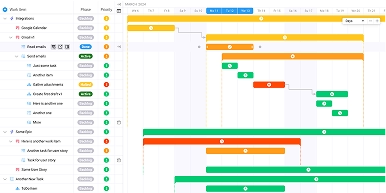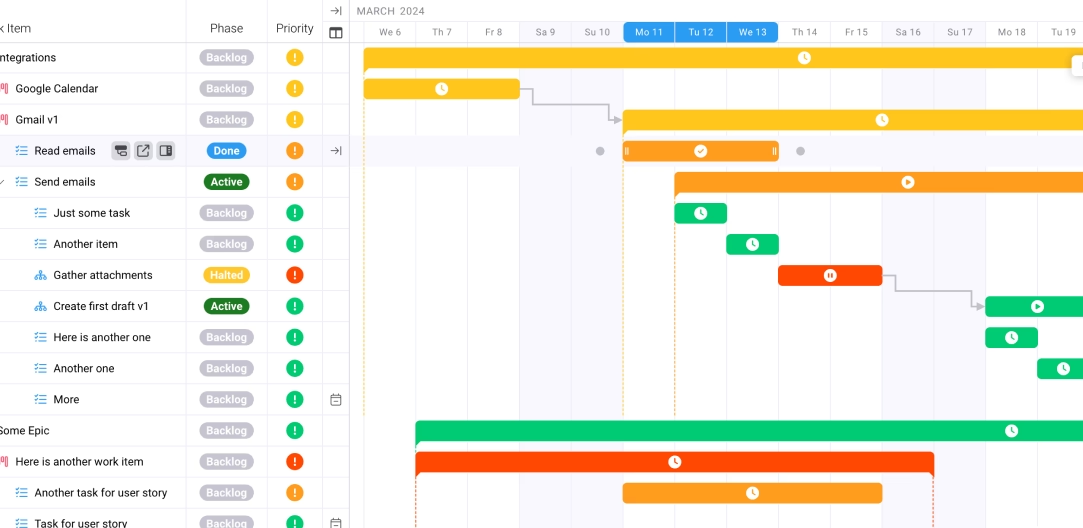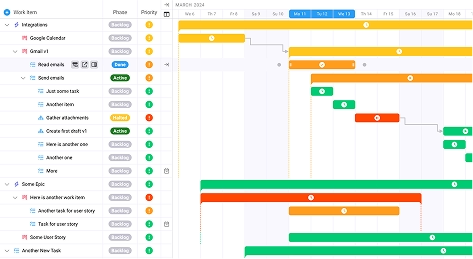
Ravetree vs. Productive: Which Is The Best Tool For Agencies?
Key takeaways:
Choosing between Ravetree and Productive is a common scenario agency owners face when selecting a management platform. 81% of marketing agency owners banking on revenue expansion by 2025 with average profit margin around 15-20% in 2024, so selecting the right work management platform isn't just an operational decision—it's survival strategy. When evaluating Ravetree vs. Productive, agencies must balance functionality, pricing, scalability, and how well each platform addresses the core challenges that make or break profitability. This comprehensive comparison cuts through marketing fluff to deliver the hard truth about which platform truly serves professional services firms best.
The Agency Management Software Market: Why This Decision Matters
The stakes have never been higher. Agency Management Software market valued at approximately USD 2.5 billion in 2023 and expected to reach USD 5.1 billion by 2032 at CAGR of 8.1%, reflecting massive industry transformation. Professional services firms face mounting pressure: marketing agencies have a net profit margin between 6.0% and 12.0%, leaving minimal room for inefficiency. Making the wrong software choice compounds operational chaos when margins are already razor-thin.
The broader professional services automation software market landscape tells an even more compelling story. The global professional services automation software market projected to reach $25.25 billion by 2030, expanding at CAGR of 11.9%, signaling massive digital transformation across creative agencies, marketing firms, and consulting practices. Some analysts project even more aggressive expansion, with the PSA market expected to reach $59.71 billion by 2030 at CAGR of 31.1%, depending on methodology.
What's driving this explosive growth? Consulting firms expected to hold 41.7% of total market revenue by 2025 within the PSA application category, with marketing and creative agencies close behind. The small and medium-sized enterprises segment anticipated to register CAGR of 12.4% from 2025 to 2034, showing that agencies of all sizes recognize the competitive necessity of comprehensive management platforms.
Why Generic Project Management Tools Fail Agencies
Before diving into Ravetree vs. Productive specifics, understanding why traditional project management software falls short for agencies clarifies what matters most. Generic tools like basic task boards or spreadsheet-based systems lack the financial intelligence agencies desperately need. When agencies should aim for a direct delivery margin of at least 70% on every project before overhead, they need real-time profitability visibility—not just task completion checkboxes.
Best agency management systems centralize project, resource, and financial management to improve team efficiency and ensure timely results. Using multiple disconnected tools for these functions creates disjointed workflows that lead to missed deadlines, scope creep, and financial discrepancies. Agencies juggling client management, project management, resource planning, time tracking, and billing across separate platforms hemorrhage both time and profit.
Research shows that agencies achieve 10-15% improvement in billable utilization rates within 6 months of implementing systematic resource management—translating directly to revenue increases without proportional cost increases. This improvement only materializes with integrated systems that connect resource allocation decisions to real-time profitability analysis, something generic tools simply cannot provide.
Ravetree: Purpose-Built for Professional Services
Ravetree positions itself as the all-in-one work management platform specifically designed for professional services firms. Unlike generic project management tools retrofitted for agency needs, Ravetree was architected from day one for organizations that bill by the hour, manage multiple simultaneous client projects, and need granular visibility into profitability metrics.
Core Ravetree Features
Ravetree's project management module offers multiple views including Gantt charts, Kanban boards, timelines, calendar views, and table views. Project managers can create detailed work breakdown structures, establish task dependencies, set milestones, and track progress against budgets and timelines. The system supports both agile and waterfall methodologies, giving agencies flexibility in how they approach different project types.
Resource planning in Ravetree goes beyond basic capacity planning. The platform provides heat maps showing resource availability, allows for tentative bookings on pipeline projects, and includes conflict resolution tools when scheduling overlaps occur. Managers can view utilization rates across the organization, identify underutilized team members, and make data-driven decisions about hiring or workload distribution. Following project management best practices essential for agency directors, the system enables proactive staffing decisions rather than reactive firefighting.
Time tracking integrates seamlessly with projects and budgets. Team members can start timers directly from tasks, enter time manually against specific services, or submit timesheets for approval. The system automatically flags hours that exceed budget allocations, providing early warning signals before projects become unprofitable. Expense tracking follows similar patterns, allowing teams to attach receipts, categorize expenses, and associate costs with specific projects or clients.
The billing module connects directly to time and expense data, supporting multiple billing models including hourly, fixed-fee, and retainer-based arrangements. Agencies can create professional invoices, track payment status, generate billing forecasts, and manage accounts receivable. Integration with accounting systems like QuickBooks ensures financial data flows seamlessly between operational and accounting systems.
Ravetree's CRM functionality helps agencies manage their sales pipeline, track deal progress, store client communication history, and forecast revenue. The system includes proposal generation tools, allowing sales teams to quickly create and send professional proposals that can be converted directly into projects once approved.
The client portal provides branded access for clients to view project status, approve deliverables, review invoices, and communicate with the team. This transparency reduces "Where are we?" emails while maintaining professional boundaries around internal team discussions.
Ravetree Pricing and Implementation
Ravetree operates on a subscription model with an all-inclusive license per user that can be billed monthly, quarterly, or yearly. The platform offers a free trial period allowing agencies to test functionality before committing. Implementation includes onboarding support, data migration assistance from existing systems, and training for admin users and team members.
Ravetree's Ideal User Profile
Ravetree best serves mid-sized professional services firms (25-250 employees) in marketing, creative, IT services, consulting, engineering, and accounting. The platform particularly excels for agencies that:
- Bill clients using multiple pricing models (hourly, fixed-fee, retainer)
- Need real-time visibility into project profitability
- Manage complex resource allocation across multiple concurrent projects
- Require robust financial management integrated with operations
- Want a single platform replacing multiple disconnected tools
Recognizing that resource planning essential for agency profitability, Ravetree consolidates critical functions into one cohesive system designed specifically for how agencies actually operate.
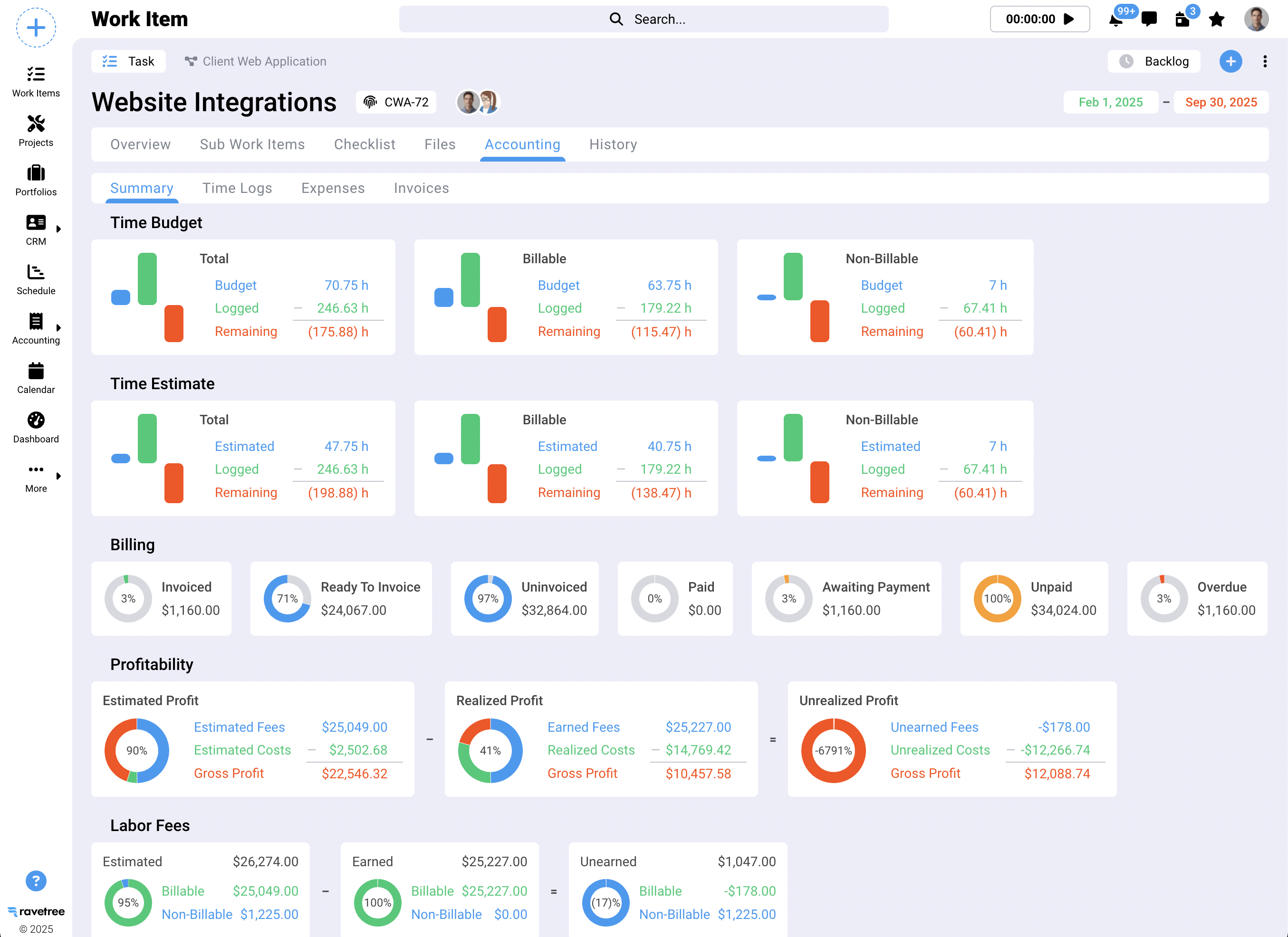
Productive.io: The All-in-One Agency Management Platform
Productive.io offers resource planning and time tracking in one platform designed specifically for agencies and consultancies. Like Ravetree, Productive was purpose-built for professional services.
Core Productive.io Features
Productive's project management capabilities include multiple view options (Gantt, List, Table, Calendar, Kanban, Workload), task management with custom statuses and automation, milestone tracking, and collaboration tools. The platform emphasizes flexibility, allowing teams to structure projects according to their preferences while maintaining organizational consistency.
Resource planning in Productive includes scheduling features with tentative bookings, placeholder resources for forecasting, utilization tracking, and conflict resolution. The heat map visualization shows capacity at a glance, helping managers identify bottlenecks before they impact delivery. The system tracks both planned and actual hours, providing insights into estimating accuracy.
Time tracking offers multiple input methods including timers, manual entry, and automatic suggestions based on resource bookings. The approval workflow ensures time entries are reviewed before billing, maintaining data quality. Integration with budgets provides real-time visibility into project burn rates.
Budgeting in Productive supports hourly, fixed-price, and mixed pricing models. The forecasting feature projects whether projects will finish in the green or red based on current trajectory. Switching to profitability view shows actual profit margins accounting for employee costs and overhead.
The financial management module includes invoicing, expense tracking, purchase orders, revenue recognition, and cash flow forecasting. Integration with accounting platforms (Xero, QuickBooks) ensures financial data synchronization. The system generates invoices automatically based on tracked time and approved expenses.
Productive's CRM module manages the sales pipeline with deal stages, probability weighting, revenue forecasting, and conversion tracking. Proposals can be generated and tracked through approval. Once deals close, they convert directly into projects with budgets intact.
Reporting in Productive is notably robust, with customizable dashboards, pivot tables, multiple grouping options, and scheduled report delivery. Financial reports cover profitability by project, client, service, or team member. Utilization reports help optimize resource allocation.
The client portal allows clients to view project status, budgets (if shared), tasks, documents, and invoices. Clients can also track their own time if appropriate for the engagement model.
Productive.io Pricing and Implementation
Productive.io Essential tier priced at $9 per month when billed annually, with Professional tier at $24/month and Ultimate tier at $32/month per user. The Essential plan includes core project management, time tracking, budgeting, and basic reporting. Professional adds custom fields, recurring budgets, advanced reports, and time approval workflows. Ultimate includes forecasting, scenario builder, overhead calculations, and HubSpot integration. A 14-day free trial provides hands-on evaluation before purchase.
Productive.io's Ideal User Profile
Productive serves professional services firms of various sizes, with particular strength for:
- Agencies prioritizing financial forecasting and scenario planning
- Teams needing sophisticated reporting and analytics
- Organizations requiring strong integration with existing tech stacks
- Firms with complex budgeting requirements across multiple pricing models
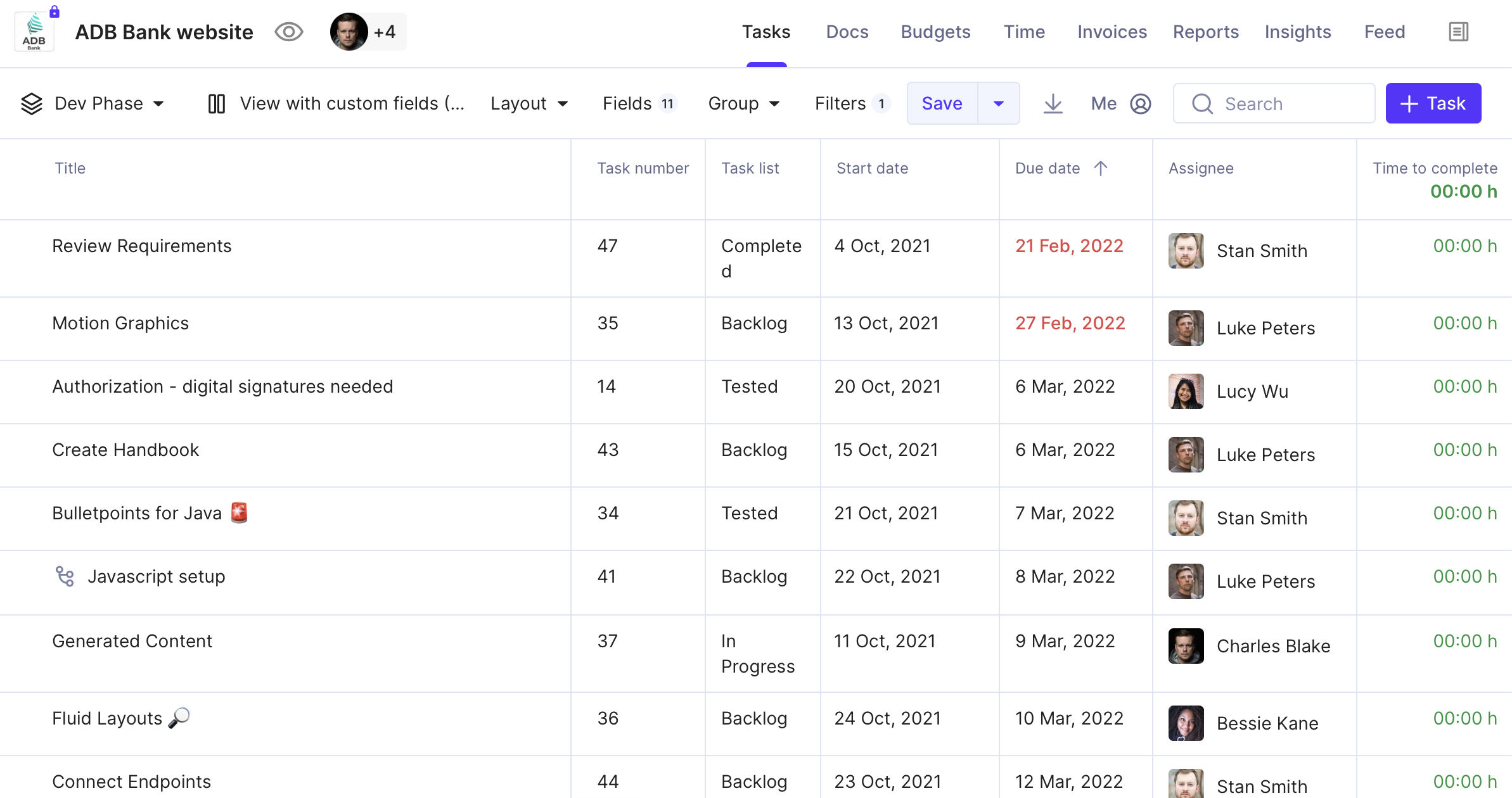
Ravetree vs. Productive: Direct Feature Comparison
Project Management Capabilities
Both platforms offer comprehensive project management with multiple view options, task management, and collaboration tools. Ravetree provides more customization in workflow automation, while Productive offers no-code automation for repetitive tasks.
Resource Planning and Scheduling
Resource planning represents a critical differentiator. Both platforms offer heat maps, utilization tracking, and conflict resolution. Productive includes scenario planning tools (placeholders, tentative bookings) that help agencies forecast hiring needs before taking on new work. Ravetree's resource planning integrates more tightly with utilization reporting from the financial side.
Time Tracking and Expense Management
Time tracking functionality is comparable across both platforms. Both offer timers, manual entry, and timesheet approvals. Expense management capabilities are similar, with both platforms supporting receipt attachments, categorization, and billability tracking.
Budgeting and Financial Management
This is where differences become more pronounced. Ravetree's forecasting features—showing projected end-state profitability mid-project—provide exceptional visibility. Ravetree's financial management runs deeper into accounting workflows, with stronger native invoicing capabilities and more comprehensive accounts receivable management. Productive offers a scenario builder that allows agencies to model "what-if" situations before committing. Agencies with sophisticated financial requirements find Ravetree's approach more complete, while those prioritizing forecasting and scenario modeling prefer Productive.
Reporting and Analytics
Both Ravetree and Productive offer advanced reporting capabilities.
CRM and Sales Pipeline
Both platforms include CRM functionality for managing deals and forecasting revenue. However, Ravetree's CRM integrates more smoothly into the sales-to-delivery workflow.
Client Portal Functionality
Client portal capabilities are similar across both platforms. Both provide branded access, project status visibility, document sharing, and communication tools. Productive allows clients to track their own time when appropriate. Ravetree's portal emphasizes document approval workflows.
Integrations and API Access
Both platforms integrate with major accounting systems (QuickBooks, Xero), and offer API access for custom integrations. Productive includes a Zapier connection for workflow automation across applications. Ravetree also integrates with HubSpot and Stripe. Integration capabilities shouldn't be a deciding factor—both platforms play nicely with standard agency tech stacks.
Ravetree vs. Productive: Pricing Analysis
Pricing structures differ significantly between Ravetree vs. Productive. Productive's transparent per-user monthly pricing makes cost forecasting straightforward. The Essential tier at $9/user/month provides basic functionality suitable for smaller agencies. Most growing agencies require Professional ($24/user/month) or Ultimate ($32/user/month) tiers to access forecasting, custom fields, and advanced reports.
Ravetree's pricing is simpler, where all plans include all functionality. Most mid-sized agencies can expect per-user costs similar to Productive's Professional tier.
Neither platform offers a consistently cheaper option—actual costs depend on specific feature requirements and team size. Agencies should request quotes from both vendors with their exact requirements rather than making assumptions based on entry-level pricing.
Ravetree vs. Productive: User Experience and Learning Curve
User interface design influences adoption rates dramatically. Ravetree's interface feels modern and polished, with intuitive navigation and clear information hierarchy. New users generally navigate the system effectively after brief orientation. The learning curve is moderate—teams become productive quickly but need time to master advanced features like custom reports and automation.
Both platforms invest in user onboarding with training resources, documentation, and customer success support. Neither presents insurmountable adoption challenges for agencies committed to implementation.
Implementation Considerations
Successful implementation of either platform requires more than software installation. Agencies must:
Data Migration: Transferring historical project data, client records, and financial information from existing systems requires careful planning. Both vendors provide migration assistance, but agencies should allocate internal resources for data validation and cleanup.
Process Standardization: Implementing new software forces agencies to document and standardize processes. This is painful but valuable. Successful implementations use the software transition as an opportunity to eliminate inefficient workflows rather than digitizing chaos.
Team Training: Comprehensive training goes beyond "click here, then here." Team members need to understand how their actions impact overall project profitability, resource utilization, and client satisfaction. Both platforms offer training resources, but internal champions drive adoption.
Change Management: Resistance to new systems is natural. Involving team members in selection, communicating benefits clearly, and celebrating early wins smooths transition. Both platforms require 2-4 months for full adoption across an organization.
Ravetree vs. Productive: Making the Decision
So which platform wins the Ravetree vs. Productive battle? Frustratingly, the answer is: it depends.
Choose Ravetree if:
- Your agency prioritizes comprehensive financial management deeply integrated with operations
- You need robust native invoicing and accounts receivable functionality
- You're consolidating many separate tools into one platform
- Your team values strong vendor support during implementation
- You're a mid-sized agency (25-250 employees) with established processes
- You prefer a platform designed specifically for professional services from inception
Choose Productive if:
- Your agency emphasizes financial forecasting and scenario planning
- Your team makes data-driven decisions requiring flexible analytics
- You're comfortable with subscription pricing scaled by features
- You want strong integration with other best-of-breed tools via Zapier
Choose Neither if:
- Your agency is very small (under 5 people) and doesn't need enterprise features
- You're satisfied with basic project management and don't require integrated financials
- Budget constraints make any subscription-based platform prohibitive
- Your processes are so unique that configuration won't satisfy requirements
The Ravetree vs. Productive decision shouldn't be made in isolation. Agencies should:
- Document Requirements: Create a detailed list of must-have vs. nice-to-have features before evaluating options
- Trial Both Platforms: Most agencies benefit from testing both systems with real projects during trial periods
- Involve the Team: Include project managers, finance staff, and team members in evaluation
- Calculate Total Cost of Ownership: Factor in implementation time, training, integration costs, and ongoing support
- Consider Long-Term Scalability: Select platforms that accommodate growth over 3-5 years
- Evaluate Vendor Stability: Assess each vendor's financial health, roadmap, and customer base
Beyond Ravetree vs. Productive: Strategic Considerations
While choosing between Ravetree vs. Productive matters, agencies shouldn't lose sight of broader strategic questions:
Process Before Technology: No software fixes broken processes. Agencies should address fundamental operational issues before implementing new systems. The best platform makes good processes great; it doesn't rescue dysfunctional operations.
The Integration Ecosystem: Neither Ravetree nor Productive exists in isolation. Agencies should map their entire technology stack—accounting, communication, design, development—and ensure chosen platforms integrate appropriately. A slightly less-feature-rich platform that integrates perfectly with existing tools often outperforms a feature-packed solution that creates information silos.
The Human Element: Technology adoption ultimately depends on people. The most sophisticated platform fails if team members resist adoption or leadership doesn't reinforce new workflows. Successful agencies invest as much in change management as in software.
Continuous Improvement: Neither platform reaches perfect configuration immediately. Agencies should plan for ongoing optimization, periodically reviewing workflows, reports, and integrations. Both vendors release regular updates—staying current maximizes value.
The Future of Agency Management Software
The agency management software landscape continues evolving rapidly. Both Ravetree and Productive invest in platform development, adding features based on customer feedback. Some trends worth monitoring:
Deeper Financial Intelligence: Platforms will provide increasingly sophisticated profitability analysis, automatically identifying unprofitable clients, services, or team members before problems compound.
Enhanced Client Collaboration: Client portals will evolve beyond status reporting into true collaboration environments where clients actively participate in project delivery.
Predictive Analytics: Machine learning algorithms will help agencies forecast utilization, identify at-risk projects, and recommend optimal resource allocation based on historical patterns.
Agencies selecting platforms today should evaluate roadmaps and vendor innovation commitment alongside current capabilities.
Conclusion
The Ravetree vs. Productive decision represents more than software selection—it's a strategic choice about how agencies operate, make decisions, and serve clients. Both platforms offer comprehensive capabilities purpose-built for professional services firms. Neither is objectively superior; each excels in different dimensions.
Productive edges ahead for agencies prioritizing forecasting and analytics. Ravetree leads for organizations needing deep financial management, customization, and comprehensive operational consolidation. Many agencies would thrive with either platform given proper implementation.
The key is avoiding paralysis. Too many agencies spend months comparing options while bleeding efficiency through disconnected systems. Set evaluation criteria, trial both platforms with real projects, involve your team, and make a decision. Imperfect action beats perfect planning.
As we've explored throughout this comparison of Ravetree vs. Productive, the best platform is the one that your team actually uses, that scales with your growth, and that transforms operational data into actionable insights. Both Ravetree and Productive satisfy these requirements—now execute your selection process and start realizing the benefits.
Frequently Asked Questions
What is the main difference between Ravetree and Productive.io?
The main difference lies in emphasis: Ravetree prioritizes deep financial management integration with comprehensive operations, while Productive.io focuses on forecasting capabilities and reporting analytics. Both offer full-featured agency management but optimize for slightly different priorities. Ravetree is considered to be more robust and customizable when compared to Productive.
Which platform is better for small agencies?
Both platforms serve small agencies effectively, though entry-level pricing and feature tiers make this decision budget-dependent. Agencies under 10 people should carefully evaluate whether enterprise features justify subscription costs or whether simpler tools suffice temporarily.
Can these platforms replace QuickBooks or Xero?
No. While both offer robust financial features including invoicing and expense tracking, neither replaces dedicated accounting software. Both platforms integrate with QuickBooks and Xero, syncing operational data with accounting systems rather than replacing them.
How long does implementation typically take?
Full implementation typically requires 1-4 weeks including data migration, configuration, and training. However, achieving team adoption and process optimization extends 2-3 months as the organization learns to leverage platform capabilities fully.
Do these platforms work for non-agency businesses?
Both platforms primarily target professional services firms including agencies, consultancies, and service-based businesses. While technically usable by other organizations, features are optimized for billable-hour services rather than product companies or retail operations. However, Ravetree is less opinionated and can work with a wider variety of business types.
What's the typical ROI timeline for these platforms?
Most agencies see positive ROI within 3-9 months through improved utilization rates, reduced scheduling overhead, and enhanced project profitability. Larger implementations with extensive process changes may require longer timelines before realizing full benefits.
Can clients access these systems?
Yes, both platforms include client portals providing branded access for clients to view project status, approve deliverables, and communicate with teams. Agencies control what information clients can access, maintaining appropriate boundaries.
What happens to our data if we switch platforms?
Both vendors provide data export capabilities allowing agencies to extract project, financial, and client data. Implementation complexity depends on destination platform and data volume
Do these platforms require long-term contracts?
Contract terms vary by vendor and plan. Productive.io generally offers monthly or annual subscriptions without long-term commitments. Ravetree offers monthly, quarterly, and yearly plans.


